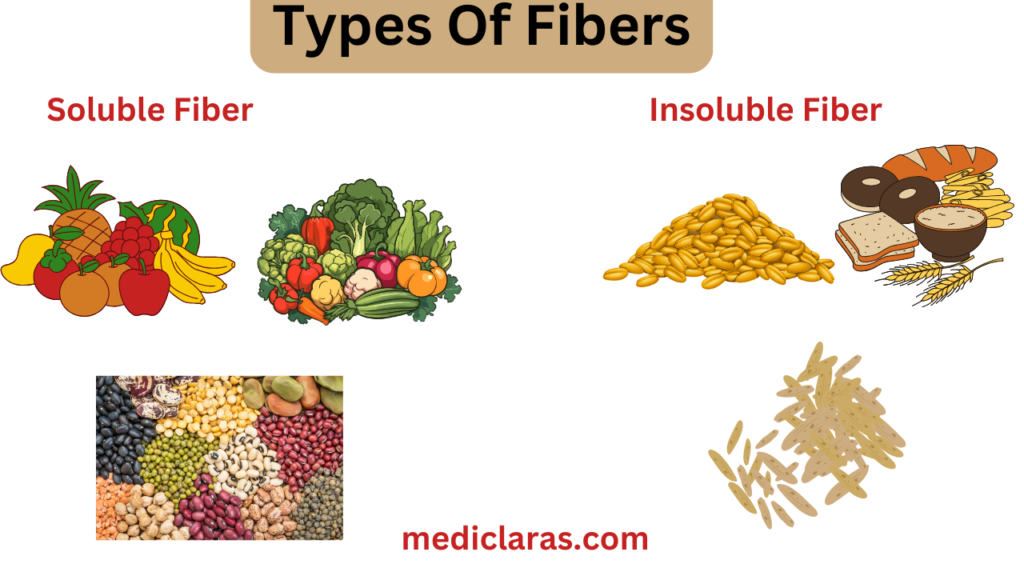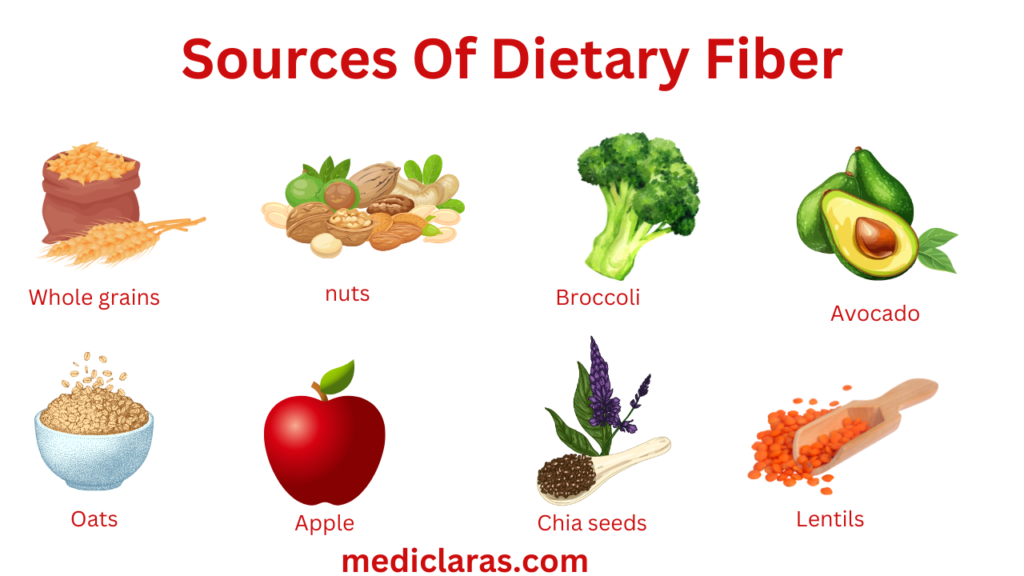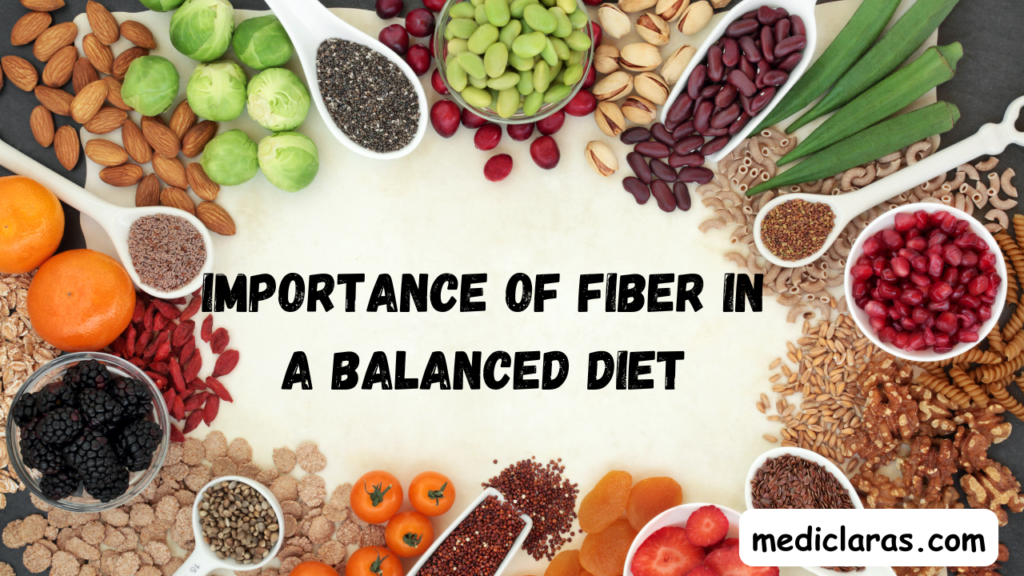The Importance of Fiber in Balanced diet: Benefits and Sources
Even though dirty fiber is not classified as a nutrient, it plays a vital role
in our diets. The main reason for the importance of fiber is that it passes
through the body without being absorbed. It also plays an important role
in impacting everything from digestion to heart health. As fiber has
prominent place in your plate. This article look at importance of fiber in a balanced diet ,benefits and source.
Understanding Fiber:
Dietary fiber is a type of nutrient classified as a carbohydrate. It is a
roughage that consists of the components of plant foods that the body is
unable to digest or absorb . This distinguishes it from nutrients like
proteins, fats and other carbohydrates such as starches and sugar.
Rather cyber travels through the stomach, small intestine and colon
without significant alteration before exiting the body.

Classification
Fiber is classified into two main types:
Soluble Fiber: This fiber mixes with water and forms a gel – like
substance in the stomach that hinders digestion. It can assist in lowering
the blood glucose levels and reducing cholesterol level. Oats ,peas,
beans ,apples, bananas, avocados ,citrus fruits ,carrots, barley and
physlum contain soluble fiber.
Insoluble fiber
This kind of fiber is not water soluble. It aids the transit of matter through
the digestive track and increases tool volume. Thus , it is beneficial for
those who suffer from constipation or do not have regular bowel
movements. Whole wheat flour ,wheat bran ,nuts , beans and
vegetables like cauliflower green beans and potatoes are excellent
sources of insoluble fibers.
Importance of fiber diet for your health :
A fiber in diet provides benefits by supporting good health in a variety of
ways.
Dietary fiber and Digestive Health
Fiber in your diet maintain your digestive health by two ways:
Reduced risk of constipation
Dietary fiber contributes to an increase in
both weight and size of stools while also softening them.it reduces the
likelihood of constipation because bulky stool can easily pass through
anus. Fiber firm up the watery and loose stools. This is due to the fact
that fiber takes up water and increases the stools mass.
Intestinal well-being:
A fiber rich diet can potentially reduce the risk of
hemorrhoids.
Consuming a high fiber diet also reduces the risk of developing
diverticulitis, a condition characterized by small inflamed pouches in the
colon wall. A fiber rich diet also has some association with lowering the
risk of colorectal cancer. Certain fibers act as nourishment for the
beneficial bacteria in the gut. This is referred to as fermented fibers. It
might contribute to a reduction in the risk of colon diseases.
Fiber diet and cholesterol level
Soluble fiber present in beans ,oats, flax seeds and oat bran prevent the
body from absorbing some of the cholesterol found in other foods. This
may lead to reduction in blood levels of low density lipoprotein which is
also known as bad cholesterol. High fiber foods might also impact heart
health in other ways including reducing blood pressure and diminishing
bodily inflammation.
Dietary fiber and weight management
Foods that are rich in fiber are generally more satiating than those that
lack fiber. A diet rich in fiber helps to guard against weight gain. Foods
that are high in fiber usually have low energy density indicating that they
have over a few calories. A person on a high fiber diet can therefore eat
the same quantity of food while taking in fewer calories.
A gel is produced by soluble fiber which reduces the speed of stomach
emptying and delays the passage of food through the digestive tract. This
prolongs the duration of a person feeling satiety.Fibre also slows down the uptake of sugars from the intestine . This aids in sustaining low blood sugar levels and avert a quick increase in blood
insulin levels, which has some association with diabetes.
Dietary fiber and Sugar Levels
Fiber is beneficial for the people with diabetes because fiber can slow
down the absorption of sugar and contribute to better blood sugar levels.
This is particularly the case for soluble fiber. Risk of type two diabetes
can also be lowered by consuming both soluble and insoluble fibers in
your diet.
Ageing and fiber intake
Fiber takes on added significance for seniors. As people age , the
digestive system slows down making a high-fiber diet increasingly
crucial.

Sources of Fibers
The fiber rich foods include:
Vegetables: such as
Broccoli Spinach
Carrot Sweet potato
Fruits:
Apples Bananas
Oranges Beans
Whole grains:
Oats Brown rice
Legumes:
Lentils Beans
Chickpeas
Nuts and Seeds:
Almonds Chia seeds
Flaxseeds
Ways to add more fiber to your diet:
As some people consume insufficient amounts of whole
grain,cereals,beans and vegetables, all of which are good sources of
dietary fiber.
Here are some ways to increase your daily intake of fiber:
● Consume cereals that are made from barely, oats or wheat in
breakfast.
● For every evening meal you should include one additional
vegetable.
● Eat some nuts ,whole meal crackers ,dried fruit or fruits as a snack.
You can easily reach a daily consumption of over 30g if you eat :
● Consume wholegrain cereal items
● Consume more fruits and vegetables because they are rich source
of fibers.
● Instead of using low fiber cakes and biscuits use nuts or seeds
To boost your intake of fiber, you don’t need to consume a lot more
calories.
When to avoid a diet high in fiber
Your health care provider might advise you to consume less fiber in
specific conditions. This could assist the digestive tract recover from a
therapy or lessen the symptoms of an illness.
After specific surgeries
Following surgery that involves the stomach or intestine, your doctor
might advise a low fiber diet for a while .your digestive system can
recover as a result.
When certain disorder symptoms worsen
Parts of digestive system get inflamed by diseases including Crohn’s
disease and ulcerative colitis. You might have to cut back on your fiber intake as symptoms worsen. When you have diverticulitis, your doctor can also advise you to consume less fiber. However, gradually
reintroducing fiber into your diet is typically necessary as the symptoms
of these disorders improve . Consult your health care provider first.
After development of constricted intestine
Some areas of intestine become narrowed in some condition like
Crohn’s disease. We refer to the constricted regions as strictures. You
might need to stick to a low fiber diet if you have strictures. This prevent
blockage in the intestine.
While receiving radiator therapy
Diarrhea and intestinal constriction are possible side effects of this
cancer treatment. This is particularly true if the radiation is directed
towards the pelvic or stomach region. Reducing fiber intake may
alleviate symptoms.
Managing gastro paresis
After eating, the stomach slowly empties in this situation. Foods high in
fiber may exacerbate the symptoms of gastro paresis.
Preparing the colon for examination
Abnormalities in the large intestine and rectum are checked by a
procedure called colonoscopy. You will probably need to eat a low fiber
diet for a few days prior to this test while you get ready for
colonoscopy, this aids in cleaning the large intestine. This in turn ,makes
it easier for a health care provider to look into your large intestine during
the colonoscopy.
Sudden fiber intake change
To prevent any bad effects, make sure you consume the required amount
of fiber and add it to your diet gradually. Abdominal discomfort and increased wind ( flatulence) may result from
abruptly switching from a low fiber to a high fiber diet .
Additionally , diets high in fiber are associated with a reduction in the
absorption of certain vital minerals
( including calcium,zinc,and iron) . This happen when these minerals are
bound by fiber ,forming insoluble salts that are subsequently expelled.
For those who are vulnerable, this may rise their chance of acquiring
deficiencies in certain minerals.
Conclusion
A healthy diet must include dietary fiber since studies have shown that
eating a diet high in fiber lowers the chances of developing a number of
diseases including as heart disease ,type 2 diabetes and several types
of cancer. Additionally fiber helps maintain digestive health.
Consuming more high fiber foods ,such as fruits and vegetables with the
skins on, or taking fiber supplements if this is not feasible will help
people boost this metric.



